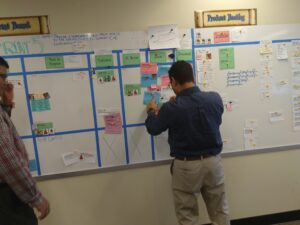What did your team decide? Where were your conversations taken? Do you think you made the right choices?
Below are the quotes you just collaborated on and the actual outcome of the team or organization. What would you have done differently?
Table of Contents
Data analysis, automated data processing or machine learning
“We just got the new data governance laws, so we will have to redo all previously released work”
Outcome: Heard from a Business Analyst on a team working on a mobile app for grocery store. The fact was not known by the Product Owner, and the company faced a Title III violation from the US Justice Department.
For improvement:
Transparency – a core agile value.
“Our website has several security violations which will have to be fixed before the next release”
Outcome: The Product Owner of a banking application received a security audit explaining these violations, and all other new development for this site stopped.
For improvement:
Maximizing value – not all development should stop. “We need 10 years of customer data always available on our website”
Outcome: the reasons for this magnitude of data were never known. The development team never asked questions of why this data was required. As a result, many delays were experienced, and much was wasted.
For improvement:
Transparency – a core agile value.Maximizing value – ask the customers the purpose behind the need
“Data needs to be absolutely pristine in order for us to be comfortable releasing it to our customer”
Outcome: This data was coming from a migration from another HR application, and as a result the new product was never released
For improvement:
Maximizing value – feedback from customers should define “pristine”Incremental releases – release a subset of data, and collect metrics on its use and field requests for more data.
“We don’t need goals for data compliance. Our group’s mission and job descriptions are clear enough”
Outcome: some customers of this Internet HR site were OK with this mindset. However, there were other customers who were upset because their priorities for data compliance were not met.
For improvement:
Responding to Change Over Following a Plan – focus on valueTransparent sprint goals – make sure your stakeholders are aware of your
“We should be fine as long as we deliver the data as requested. The numbers speak for themselves”
Outcome: this team of statisticians decided to skip Sprint reviews altogether. The outcome was that releases did not have any context, and customers misinterpreted the statistics that were delivered.
For improvement:
Sprint reviews – sprint reviews are working sessions that are designed to gather feedback from stakeholders so that a shared understanding of the released product is knownTransparency – transparency is the first step to empiricism, which leads to inspection and adaptation. Empiricism creates a shared understanding of the working product.
“The data model contains a solid domain and functional model, and our data is pretty clean. That should be enough for machine learning.”
Outcome: this team was working on an application to automatically generate resumes for candidates. This approach in the application worked for a while, however, further releases indicated that a key human element was missing.
For improvement:
Sprint reviews – feedback from stakeholders would have pointed out these flaws immediately.“Inductive (supervised) machine learning does not consider enough risk factors to be ready for prime time”
Outcome: This quote was heard in the team space of a large insurance organization. The outcome was that a developer on the team formed a startup that was open to experimentation. This new startup was able to try ideas with new customers and gather feedback to know the risk from multiple releases.
For improvement:
Ability to innovate – agile spaces are designed to mitigate risk and open to experimentation. This mindset leads to high value“Machine learning? Our company will never be ready for it! … even if we had the data, the computing power and cost is way too much”
Outcome: this idea stemmed from a discussion to reduce the time wasted for humans to sift through a lot of data gathered on a meter reading application for a utility website. The idea was never tried, and as a outcome more people were hired to support the expanding customer base
For improvement:
Agility scaling – try a small experiment with a small amount of data, which can be done relatively inexpensively.“We found customer credit card numbers in production logs for our website, but it’s OK since the general public cannot access web server logs.”
Outcome: eventually this airline reservation system was hacked, and customers credit card numbers were stolen from the website’s developer logs
For improvement:
definition of done – your definition of done should include security concerns for all environments that your application touches.Diversity and Inclusion
“The colors on our website are not ADA compliant”
Outcome: Heard from a VP responsible for delivering a mobile app for grocery store. The fact was not known by the Product Owner, and the company faced a Title III violation from the US Justice Department.
For improvement:
definition of done – Does your DoD include all customer needs?Transparency – find a way to “see comething, say something
“A software development team of introverts is best”
Outcome: a manager of a pharmaceutical application told this to a human resources manager to fulfill open jobs. The resulting team was not collaborating in scrum events and were often confused of delivering required business needs
For improvement:
Collaboration – agility does nothave a one-size-fits-all team combination. A safe space of diverse individuals usually collaborates best.
“Any personnel complaints must be addressed through HR”
Outcome: this was an official policy set in eight department of a large bank. Teams would rarely meet Sprint goals because of the overhead needed to resolve conflict. Releases were seldom.
For improvement:
Self-organizing teams – a core value of agility. Conflict is natural on an agile team. A mature self-managing team learns how to respectfully resolve conflict and get business needs to done.“A manager needs to be on the team to help keep everyone on task”
Outcome: trust was not seen by team members, and very little changed. The true value of agility was never realized.
For improvement:
self-organizing teams – A team with a set of shared values forms a strong trust bond with one another and requires very little manager supervision. The outcome is a team that can meet business needs frequently.“The most important team members are those who can stay busy.”
Outcome: a manager of a health care application saw that some team members did not assign themselves to tasks during a daily stand up. The ultimate outcome of this managers interactions were ensuring that tasks were assigned. However, nothing ever got to done.
For improvement:
focus on Done – agile is about maximizing value. Agile is not about maximizing busynessself-organizing teams – no one can tell the members of a self organizing team how to manage the work. It is up to them to decide how it gets to done.
“We simply need senior people on our [product] team in order to survive the aftereffects of the pandemic.”
Outcome: the product development cost skyrocketed for this retail application. More layoffs happened and eventually the entire company was dissolved.
For improvement:
Ability to innovate – A team with a mixture of diverse skill levels is best. Senior members with domain knowledge mixed with less experienced members with new ideas can help a organization innovate effectively.For improvement:
Scaling – creating new product lines with senior members and mixing in less experienced members well allow for experimentation into new ideas to explore for an organization/.“Our team has evolved enough to not provide estimates”
Outcome: members of this banking application were able to effectively set goals, get work done karma and collect feedback regularly. The only estimation that was needed was whether a request could fit into one Sprint.
For improvement:
not much – estimating is considered a waste on an agile team. The most important thing was to get work done and maximize value. This team already had a continuous improvement mindset.“Onboarding is too daunting a task for this team to take on which is why management should be very selective for the team.”
Outcome: no new development was allowed for this scheduleing application either. There were many issues facing this team, and the outcome was that the application was terminated because of lack of customer interest.
For improvement:
self-organization – a team that is fully capable to self organize can allow new members to collaborate on the team with high trust.“This team is a conflict-free zone”
Outcome: the manager of this ITSM application siloed each team member into a specific role to prevent conflict. The outcome was that work was done very slowly. The true value of Agility was not realized.
For improvement:
self-organization – healthy conflict on a agile team is normal. The ability for a team to resolve its own conflicts builds trust between members, and work can often be shared.Register Now!

Applying Professional Scrum for Software Development | Dec 9-11, 2024 | Live Virtual Class
Dec 09, 2024 - Dec 11, 2024








